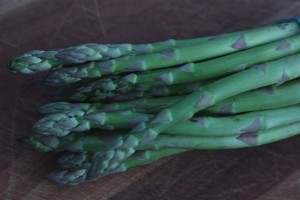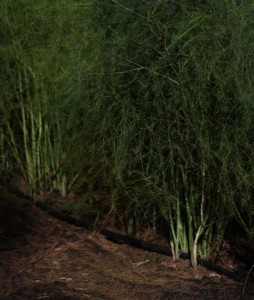No Longer Available
For those of you who’ve had the good fortune of eating fresh-from-the-field Asparagus you know the flavor can be incredible compared to the store-bought variety.
We harvested some this past year from our 4-year-old plants for our family. We ate it fresh from the field with dinners – steamed with some garlic, sea salt and a bit of pepper – wow, was it delicious!
We also blanched and froze some for the first time. Since the end of the fresh season, we’ve prepared our frozen Asparagus for a few family dinners. We were so pleased with the flavor and structural integrity our Asparagus retained.
The additional nutritional information and preparation/storage methods listed below are also available as an easy-to-print Asparagus Information Sheet (PDF).
“Americans doubled our per capita consumption of asparagus between 1997 and 2008. That is a good thing because this delicious vegetable is high in nutrients like vitamin K, folate, vitamin C, vitamin A… and also contains healthy phytochemicals like glutathione and rutin. Asparagus is still a relatively small part of our vegetable consumption at 1.2 lbs/person compared to broccoli at 5.9 lbs, sweet corn at 9.2 lbs, or fresh tomatoes 18.5 lbs.” – USDA data
- What Makes Asparagus Healthy?*
- Nutritional Content of Asparagus*
- How to Prepare Fresh Asparagus*
- Blanching & Freezing
*Courtesy of the Washington Asparagus Commission.
What Makes Asparagus Healthy?
Asparagus is one of nature’s true food heroes as a source of protein, vitamin A, vitamin C, vitamin B6, calcium, fiber, and iron. Asparagus is also packed in the naturally occurring phytochemicals of glutathione (a potent anticarcinogen and antioxidant), rutin, and folic acid. Asparagus, next to orange juice, is regarded as the second best whole foods source of folic acid. Folic acid is known to lower the risk of heart disease, colon cancer, liver disease, and spina bifida.
Nutritional Content of Asparagus (5.3 ounces)
% of Recommended Daily Allowance:
Protein – 6% | Vitamin B6 – 10% | Vitamin C – 20% | Folacin – 60%
Calories – 20 | Fat/Cholesterol – 0 g | Potassium – 400 mg | Sodium – 5 mg
Protein – 3 grams | Dietary Fiber – 3 mg | Carbohydrates – 3 grams
How to Prepare Fresh Asparagus
Buying Tips: Buy firm, straight, uniformly sized spears with closed, compact tips. The stalks should be crisp, not wilted.
Storage: Asparagus is best enjoyed immediately after purchasing.
Asparagus may be stored for longer periods of time simply by placing bundled stalks upright in a bowl or dish with an inch of water (or just enough to keep the stalks moist).
Another method is to wrap the cut ends in a moist paper towel. Cover the towel with plastic and refrigerate.
Preparation: Rinse in cool water to clean. Snap-off or trim at least ½ inch from bottom of each spear.
Boiling: Place ½ cup water in a skillet. Cook asparagus in boiling water until crisp-tender, about 6 minutes.
Steaming: Place asparagus in steamer with 1-½ to 2 inches of water. Cover and cook until crisp-tender, about 6 minutes.
Microwave: Place asparagus in baking dish with tips pointed towards center. Add ¼ cup water and cover. Microwave at 100% power for 4-7 min. (spears) 3-5 min. (pieces).
Blanching & Freezing
This is great for enjoying Asparagus long after the fresh season is over!
Items Needed:
Large size freezer bags & magic marker Towels or paper towels, counter area
1 large pot for boiling water 1 large pot for ice water bath (or use kitchen sink)
Steps:
1. Prepare freezer bags by marking the date on each bag. This will provide the date of freezing for rotation out of freezer.
2. Prepare large pot with boiling water. Prepare other large pot or kitchen sink with ice water. Ice cubes can float in water during Step 5.
3. Cut fresh Asparagus to desired length. We like 6 – 9″. Cut it too short and it’s difficult to remove from boiling water in Step 5.
4. Place 1-2 lbs of Asparagus into boiling water for 3 minutes exactly. Do not exceed 3 minutes – it will result in mushy Asparagus.
5. Remove Asparagus from boiling water with tongs and immediately place it into the ice water bath for 1 minute.
6. Remove from ice water and lay on towel for drying. Use towel to gently pat dry on top.
7. Put into freezer bags according to your expected serving sizes – we usually put in 1 lb per freezer bag, but you can put in more if you like.
8. Push air out of each bag and close. Put directly into freezer.
9. When you’re ready to prepare you can microwave for approx 3 min. in a covered dish and season to your liking. It can also be steamed. Just remember since you’ve already boiled it for 3 minutes before freezing, it will not require as much cooking time as when fresh.
We’ve found that blanching & freezing retains nearly all the flavor and fullness for months!


